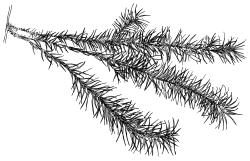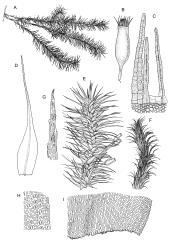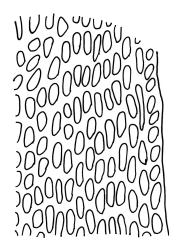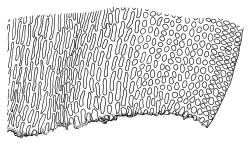- ≡ Anictangium setosum Hedw., Sp. Musc. Frond. 43 (1801)
- ≡ Neckera setosa (Hedw.) Hook., Musci Exot. 1, 7 (1818)
- ≡ Cladomnion setosum (Hedw.) Wilson, Bot. Antarct. Voy. II (Fl. Nov.-Zel.) Part II, 100 (1854)
Plants robust, on tree trunks or vertical rock, forming loose tufts that are weakly pendent and curved upward away from the substrate, yellow- or brown-green. Primary stems creeping, sometimes eroded. Secondary stems (stipes), irregularly or subpinnately branched, commonly curving upward from the substrate, dark brown and very stiff, (15–)60–120(–160) mm, in cross-section with little internal differentiation, lacking a central strand. Leaves of secondary stems and branches not differentiated, erect-appressed, somewhat flexuose, and with a few weak to strong longitudinal pleats on each side of the costa when dry, smooth, erect-spreading and sometimes weakly homomallous when moist, abruptly tapered from an oblong-obovate, concave, and non-clasping base to a long, subulate apex, (4–)5–7(–9) × 1.2–1.4 mm; margins sharply and singly toothed by projecting cell-ends and partially bistratose in the subula, entire and unistratose in the base; upper laminal cells (near base of the subula) mostly oblong to rounded-subquadrate, smooth, mostly 12–21 × 6–9 µm (but a few longer and narrower), partially bistratose; interior laminal cells of the leaf base linear, thick-walled, strongly porose, smooth, mostly (60–)75–100 µm long, unistratose; marginal laminal cells of the leaf base rounded-oblate to rounded-subquadrate in c. 12–15 rows that extend to the shoulder, thick-walled, lacking pores, with fine, ± radiate cuticular striations or smooth; extreme basal cells and alar cells not differentiated; costa narrow (c. 60 µm wide near base), percurrent to short excurrent, weakly toothed at back above (the teeth not visible under stereoscope), in cross-section (in leaf base) biconvex, with abaxial and adaxial stereids enclosing a single central layer of guide cells, becoming ± semi-circular in the subula.
Dioicous. Perichaetia scattered on secondary stems and branches, the leaves about half the length of vegetative leaves, with marginal cells less differentiated and costa ± filling the subula. Perigonia rarely seen, gemmiform, scattered on secondary stems, c. 1.5 mm, the inner bracts yellow, ovate-lanceolate, mostly ecostate, surrounding numerous antheridia and yellow filiform paraphyses. Setae straight, smooth, brown, and twisted to the left above, c. 3–4 mm; capsules exserted beyond the perichaetial leaves, erect, symmetric, oblong-cylindric, smooth and little altered when dry, brown at maturity, c. 3 mm; mouth transverse; exothecial cells mostly oblong to ± irregular, firm-walled, not thickened in corners; stomata very few and difficult to see at the extreme capsule base; annulus absent; operculum obliquely rostrate, 1.5–2.0 mm. Peristome double; exostome teeth yellow-brown, linear-lanceolate, c. 580–750 µm, inwardly circinate when dry, with a straight abaxial median line, baculate-spinose below, with robust adaxial lamellae and usually appearing crenulate at margins; endostome segments arising from a very low membrane, straight when dry, nearly the height of the exostome teeth, pale brown, baculate throughout, lacking cilia. Calyptra cucullate, smooth, and naked. Spores round, 9–11 µm diam., smooth.
Sastre-De Jesús 1987, figs 1 & 3; Brotherus 1925, figs 507a-b, 509. The curvature of the stems and branches is inadequately shown in Image: Image\1ZDR, A and is better shown in Brotherus’s fig. 509a.
Cyrtopus setosus is most likely and often confused with Cryptopodium bartramioides. Cyrtopus setosus is a more compact plant with shorter, broader (c. 5–7 × 1.2–1.4 mm vs c. 8–12 × 0.7–0.9 mm), and more abruptly tapered leaves. The marginal teeth in C. setosus are single and the abaxial costal surface weakly toothed (both are difficult to observe under a hand-lens). By contrast, the marginal and costal teeth of Cryptopodium bartramioides are paired and readily seen with a hand-lens. In C. setosus the laminal cells of the leaf base are dimorphic and have cuticular striations (observable under the compound microscope; not illustrated in Plate 1), while in Cryptopodium bartramioides the cells of the leaf base are uniformly short-rectangular and smooth. In C. setosus the setae are 3–4 mm and the capsules exserted beyond the perichaetial leaves (but only weakly exserted beyond the longer vegetative leaves), while in Cryptopodium bartramioides the setae are shorter and the capsules immersed among non-differentiated perichaetial leaves. The two plants also differ by their peristome structure and usually occur on different host species.
Confusion may also occur with Echinodium hispidum, but in that species the leaves are dark green and somewhat falcate secund, with capsules well exserted on longer and curved setae.
NI: N Auckland, including offshore islands (HC, LB, GB), S Auckland, Gisborne (Hicks Bay, Cape Runaway, near Gisborne), Hawke’s Bay (Wairoa, Māhia Peninsula), Taranaki, Wellington (including KA). SI: Nelson, Marlborough (Queen Charlotte Sound, Pelorus Bridge Scenic Reserve), Westland (s.loc.), Otago (Lake Wānaka, Catlins), Southland; St.
Apparently Australasian, but the few occurrences outside N.Z. are poorly documented. Scott & Stone (1976, p. 365) recorded it without detail from Queensland and Tasmania, but neither locality was confirmed by Sastre-De Jesús (1987). Dalton et al. (1991) rejected the Tasmanian record. Sastre-De Jesús (1987) recorded one specimen collected by Brass from Normanby Island in Papua New Guinea, and one 19th century (Wilkes Expedition) collection, purportedly from Hawai’i. The latter seems particularly doubtful.
This species occurs on a wide range of flowering tree species including Beilschmiedia tawa, B. tarairi, B. tawaroa, Dysoxylum spectabile, Knightia excelsa, Laurelia novae-zelandiae, Melicytus ramiflorus, and Weinmannia racemosa, as well as Agathis australis, Dacrydium cupressinum, Dacrycarpus dacrydioides, and Prumnopitys ferruginea. It appears to be most abundant in Beilschmiedia tawa dominated forests on smooth-barked trees. It most often forms extensive mats (to at least 2 × 0.5 m) on tree trunks, but occasionally occurs on vertical rock faces. This species is most common in the northern portion of the North I., but it is also relatively common in Wellington and Southland L.D. The relatively few collections seen from the eastern North I. (Gisborne and Hawke’s Bay L.D.) are sterile and stunted. No collections have been seen from Canterbury L.D., or inland parts of Otago L.D. There are very few records from Marlborough L.D., and from Westland L.D. it is known from a single unlocalised collection by T. Kirk (WELT M003392). Cyrtopus setosus very often co-occurs with Orthorrhynchium elegans; other associates include Camptochaete spp., Cladomnion ericoides, Leptostomum inclinans, Lopidium concinnum, Weymouthia cochlearifolia, and Plagiochila spp. On North I. from 60 m (Logues Bush, N Auckland L.D.) to at least 550 m (Mt Wainui, Wellington L.D.); on South I. from near sea level to c. 220 m (Ōpārara Valley, Nelson L.D.), but there is a single W. Martin collection from Lake Rotoiti (Nelson L.D., CHR 308309) which presumably came from a site at more than 620 m a.s.l.
Given the frequency with which C. setosus fruits, perigonia are surprisingly rarely found in herbarium material. Perigonia can sometimes be located by searching for leaves which are more concave basally than adjacent vegetative leaves.













